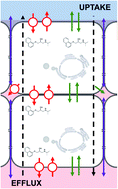Developing in vitro models to assess fish gill excretion of emerging contaminants
Abstract
Advances in analytical methods have enabled the detection of emerging contaminants at ever lower concentrations in freshwaters. However, such measurements need to be linked to effect-based assays to identify risks. The bioconcentration factor (BCF) forms part of a chemical's environmental risk assessment (ERA), and current regulatory testing guidelines to calculate fish BCFs use hundreds of fish per chemical. Due to ethical concerns a reduction in the numbers of animals used is desired, and there is a need to identify in vitro or in silico alternatives which meet regulatory acceptance. This study describes the successful demonstration of a FIsh Gill Cell culture System (FIGCS) to assess an often overlooked parameter in pharmacokinetics: the excretion of drugs across the gill. The FIGCS tolerates the application of natural waters on its apical surface, mimicking the situation of the live fish, and thus in combination with advanced analytical methods, offers an opportunity to take lab-based testing used for ERA, such as compound uptake, biotransformation or excretion directly into field for validation with natural waters. Here we used the basic drug propranolol and the acidic ibuprofen as a demonstration of the FIGCS utility in three separate experiments. Excretion across the apical membrane showed saturation kinetics, suggesting the involvement of carrier-mediated processes. Both propranolol and ibuprofen were excreted across the epithelium from the media (internal blood equivalent) to the water, with ibuprofen excretion being considerably slower than propranolol excretion. Further studies indicate that ibuprofen may be complexing with fetal bovine serum (FBS) reducing bioavailability; in contrast propranolol efflux rate was unaffected, indicating that drugs behave differently in the presence of FBS and other plasma proteins. A key issue in future ERA is to better understand the effects of mixtures of different pollutant classes found in environmental samples, and this model offers an ethical path to do this.

- This article is part of the themed collection: Analytical Methods HOT Articles 2021


 Please wait while we load your content...
Please wait while we load your content...